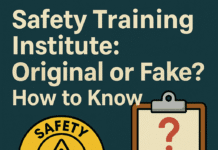
CRSP (Canadian Registered Safety Professional)
CRSP : In a world where safety is paramount, professionals who dedicate themselves to preserving and enhancing the well-being of individuals in workplaces play a vital role. The Canadian Registered Safety Professional (CRSP) is an esteemed certification that represents excellence in the field of occupational health and safety. This article will delve into the world of CRSP, exploring its significance, the journey to becoming a CRSP, the responsibilities and impact of CRSPs, and much more.
Introduction to CRSP
Definition of CRSP
The Canadian Registered Safety Professional (CRSP) is a nationally recognized certification awarded to individuals who demonstrate their proficiency and commitment to ensuring the safety and health of workers in various industries. CRSPs are experts in identifying and mitigating workplace hazards, thus contributing to a safer working environment.
Importance of Safety Professionals
Safety professionals are the unsung heroes of the workplace. Their expertise in risk assessment, hazard control, and safety management directly impacts the well-being of employees. By promoting a safe work environment, they help reduce accidents, injuries, and even fatalities.
The Role of CRSPs in Canada
CRSPs are at the forefront of workplace safety in Canada. They work tirelessly to ensure that organizations comply with safety regulations, implement best practices, and continuously improve safety measures.
Becoming a CRSP
Eligibility and Requirements
To become a CRSP, one must meet specific eligibility criteria, including relevant education and work experience. Additionally, applicants must pass a comprehensive certification exam.
The Certification Process
The certification process involves rigorous testing to evaluate a candidate’s knowledge and skills in occupational health and safety. Successful candidates earn the prestigious CRSP designation.
Benefits of Becoming a CRSP
Becoming a CRSP offers numerous advantages, including increased employability, career advancement, and a competitive edge in the job market.
The Responsibilities of a CRSP
Occupational Health and Safety Management
CRSPs are responsible for managing safety programs, conducting workplace inspections, and ensuring that organizations comply with safety regulations.
Risk Assessment and Hazard Control
They assess potential risks, implement control measures, and develop emergency response plans to minimize workplace accidents.
Legal and Ethical Considerations
CRSPs must navigate complex legal and ethical considerations, often acting as advocates for worker safety within their organizations.
The Impact of CRSPs
Reducing Workplace Accidents
One of the primary contributions of CRSPs is a significant reduction in workplace accidents and injuries, leading to a safer and more productive work environment.
Enhancing Workplace Safety Culture
CRSPs play a crucial role in fostering a culture of safety within organizations, ensuring that safety is a top priority for everyone.
Saving Costs for Organizations
By preventing accidents and injuries, CRSPs help organizations save money on medical expenses, legal costs, and potential fines.
CRSP vs. Other Safety Certifications
CRSP is often compared to the Certified Safety Professional (CSP) certification. While both certifications have their merits, CRSP is tailored to the Canadian context and enjoys recognition and respect within the country.
Regional and International Recognition
CRSP is widely recognized in Canada and has gained international recognition in regions where Canadian safety standards are considered exemplary.
Continuing Education and Professional Development
The Importance of Staying Updated
Safety standards and regulations are constantly evolving. CRSPs must engage in continuous learning to stay updated on the latest safety practices.
Available Resources for CRSPs
Various organizations and associations provide resources, conferences, and workshops to support the ongoing professional development of CRSPs.
Networking Opportunities
CRSPs have the opportunity to connect with other safety professionals, share knowledge, and gain insights from their peers.
Challenges Faced by CRSPs
Coping with Evolving Safety Regulations
Adapting to changing safety regulations and standards can be a significant challenge for CRSPs, requiring continuous education and vigilance.
Managing Workplace Resistance to Change
Implementing new safety measures may face resistance from employees and organizations, requiring diplomacy and persuasion skills.
Balancing Administrative and Fieldwork
CRSPs often find themselves juggling administrative responsibilities with on-site safety inspections, demanding effective time management.
Industries that Employ CRSPs
CRSPs find employment in various sectors, including manufacturing and construction, healthcare, education, and the oil and gas industry.
Success Stories of CRSPs
Profiles of Accomplished Safety Professionals
Highlighting successful CRSPs and their notable contributions to workplace safety.
Their Contributions to Safety
These stories showcase how CRSPs have made a tangible difference in enhancing safety within their organizations.
The Future of CRSP
Anticipated Trends in Safety
Exploring the emerging trends in occupational health and safety that will shape the role of CRSPs in the future.
Career Prospects for CRSPs
The article discusses the promising career prospects and opportunities for individuals pursuing a CRSP certification.
Conclusion
In conclusion, the role of the Canadian Registered Safety Professional (CRSP) is indispensable in creating safe and secure workplaces. CRSPs reduce workplace accidents, enhance safety culture, and save costs for organizations. As the world of occupational health and safety continues to evolve, the importance of CRSPs remains significant.
SAMTRAC vs Other Safety Certifications
Construction Health and Safety Technician (CHST) Certification
FAQs (Frequently Asked Questions)
1. What is the difference between a CRSP and a CSP?
CRSP and CSP are both safety certifications, but CRSP is specifically tailored to the Canadian context, whereas CSP is more widely recognized internationally.
2. How can I become a CRSP?
To become a CRSP, you must meet eligibility criteria, pass a certification exam, and maintain ongoing professional development.
3. What industries employ CRSPs?
CRSPs find employment in a range of industries, including manufacturing, construction, healthcare, education, and the oil and gas sector.
4. What is the importance of networking for CRSPs?
Networking provides CRSPs with opportunities to share knowledge, gain insights, and stay updated on the latest safety practices.
5. What is the future of the CRSP certification?
The future of CRSP certification is promising, with emerging safety trends and ample career prospects for certified professionals.

























how to do CRSP course, would like to know more about the same